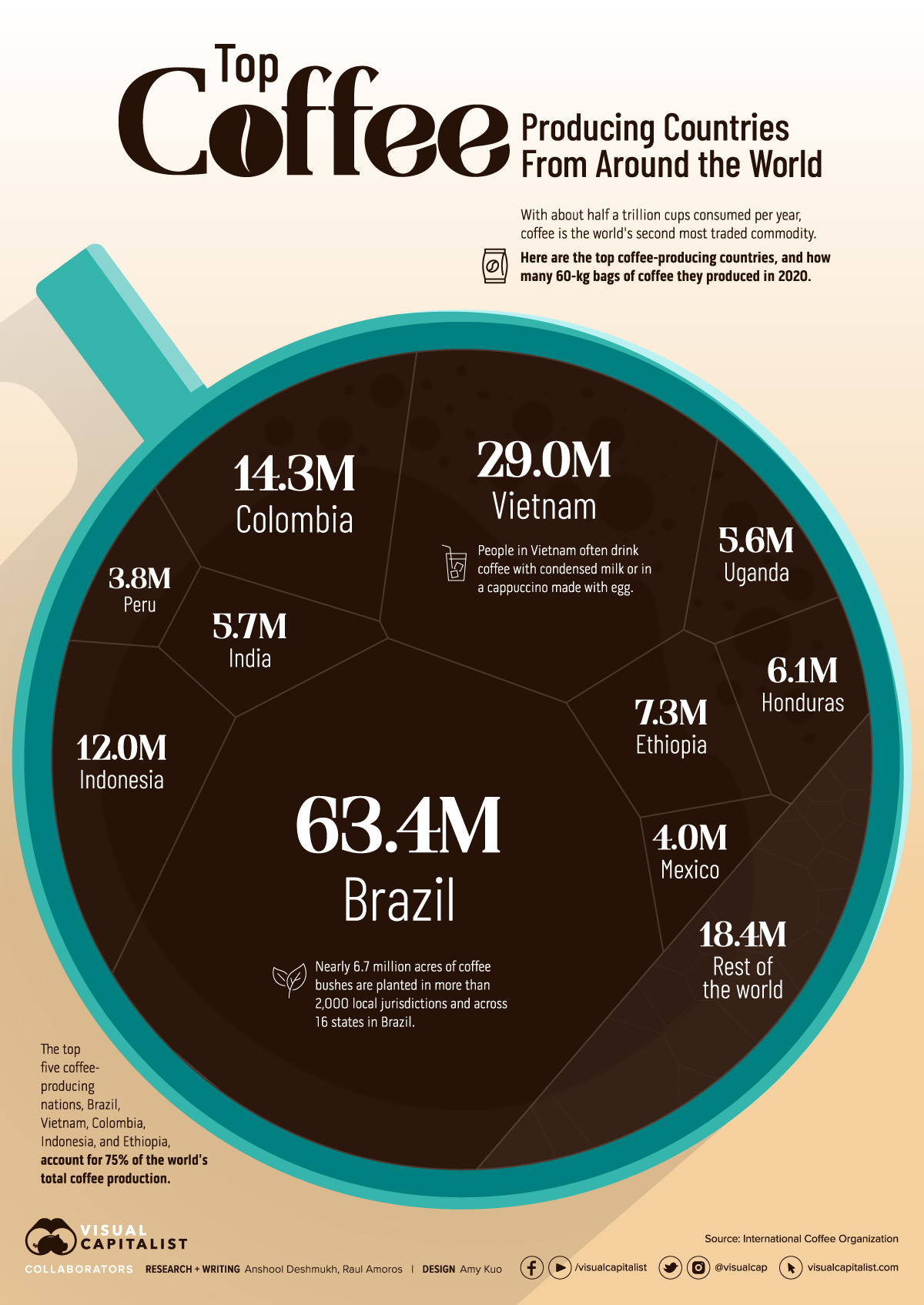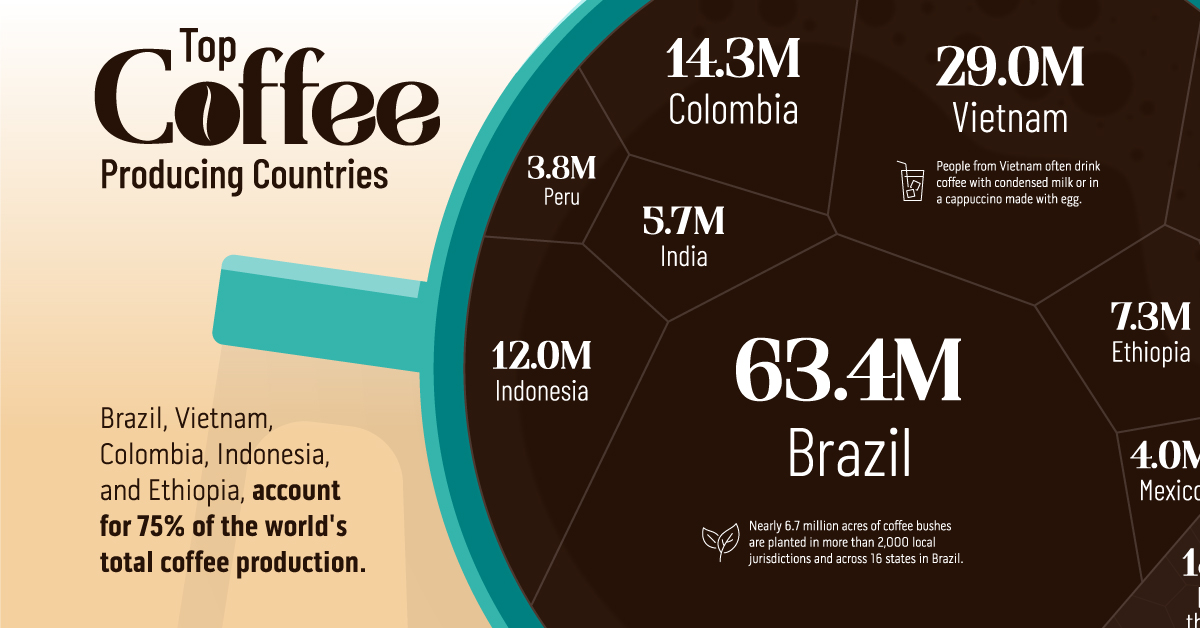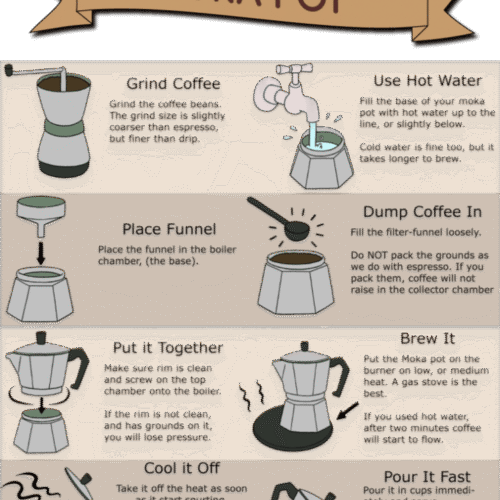Brazil is the largest coffee producer in the world. This South American nation has maintained its position as the top coffee-producing country for over 150 years.
Brazil’s dominance in coffee production is a result of its vast landscape, favorable climate, and strong agricultural infrastructure, which combine to create an ideal environment for coffee plantations. With regions such as Minas Gerais, São Paulo, and Espírito Santo leading in coffee production within the country, Brazil not only meets its own demand but also serves as a major supplier to the global coffee market.
Renowned for their traditional coffee farming techniques, Brazilians have expertly balanced mass production with quality, continually innovating cultivation practices to remain at the forefront of the coffee industry. This has ensured that Brazilian coffee beans are a staple in blends around the world, cementing Brazil’s reputation as a coffee powerhouse.

Credit: www.visualcapitalist.com
The Global Coffee Landscape
The aroma of freshly brewed coffee is a universal language, speaking to people around the world. It’s no surprise that coffee is one of the most traded commodities globally. Across continents, countries take pride in their contribution to the coffee market. Let’s dive into the intricacies of the global coffee landscape, discovering where the world’s most beloved beverage originates from.
Top Coffee Producing Regions
Brazil has long been the titanic force in coffee production, with vast landscapes dedicated to coffee plantations. Vietnam follows closely, surprising many with its robust coffee industry. Columbia and Indonesia also rank among the giants, each with unique flavors and techniques. Ethiopia, often considered the birthplace of coffee, continues to export its distinctive varieties to a growing global audience.
| Country | Annual Production(Metric Tons) |
|---|---|
| Brazil | 2,680,515 |
| Vietnam | 1,542,398 |
| Columbia | 754,376 |
| Indonesia | 668,677 |
| Ethiopia | 471,247 |
Factors Influencing Coffee Production
Several factors determine a country’s success in coffee production. Climate is pivotal; coffee plants flourish in tropical zones known as The Bean Belt. Altitude also plays a role; some of the best coffees grow in high-elevation regions. Economic conditions, such as infrastructure and access to technology, directly affect the quantity and quality of the coffee produced. Lastly, agricultural practices influence the sustainability and resilience of coffee farming, shaping the future of coffee production.
- Climate: Tropical environments provide ideal conditions.
- Altitude: Higher elevations often yield superior beans.
- Infrastructure: Better logistics lead to greater output and quality.
- Agricultural Practices: Eco-friendly techniques ensure long-term production.

Credit: www.visualcapitalist.com
Crowning The Coffee Champion
Welcome to the thrilling quest to discover which nation reigns supreme in the world of coffee production. It’s a global competition where the aroma of success is measured in sacks and the title of Coffee Champion is fiercely contested. Join us as we traverse the globe, from lush highlands to sprawling estates, in pursuit of the answer to this caffeinated conundrum.
Current Leading Coffee Producers
The battle for the top spot in coffee production is constantly brewing. Today, we see an ever-changing leaderboard of countries, with new contenders rising and established powerhouses maintaining their hold. Let’s peek at the current titans of the coffee bean world:
- Brazil – A behemoth in output, consistently holding the pole position.
- Vietnam – A robust competitor, especially in robusta beans.
- Colombia – Renowned for high-quality arabica beans.
- Indonesia & Ethiopia – Both making strong claims with unique profiles.
| Country | Annual Production (in metric tons) | Notable Bean Type |
|---|---|---|
| Brazil | 2,680,515 | Arabica, Robusta |
| Vietnam | 1,542,398 | Robusta |
| Colombia | 810,000 | Arabica |
| Indonesia | 660,000 | Arabica, Robusta |
| Ethiopia | 384,000 | Arabica |
Historical Dominance In Coffee Production
From the 1800s, certain nations brewed their way into history with their coffee production prowess. Traditions, cultures, and economic booms have all played a part in shaping this illustrious history. Notable historical champions include:
- Brazil: Not just a modern giant but a historical one, leading since the 1800s.
- Colombia: Climbed to prominence in the 20th century, known for its “Coffee Triangle”.
- Indonesia: A Dutch colonial legacy that turned into an enduring coffee culture.
- Kenya & Yemen: Both important historically, with Yemen being the birthplace of cultivation.
These nations’ historical contributions paved the way for coffee’s global journey, each adding its chapter to the rich tapestry of coffee heritage and establishing benchmarks for excellence.
Brazil’s Coffee Dominance
Brazil stands tall as the world’s top coffee producer, renowned for its vast plantations stretching across the country. This South American giant has maintained a strong foothold in the global coffee market, bringing rich flavors into the cups of millions daily. Let’s delve into what makes Brazil’s coffee industry so remarkable and resilient.
Factors Behind Brazil’s Coffee Industry
Brazil’s supremacy in coffee production lies in several key factors:
- Ideal climate: With its warm temperatures and gentle rains, Brazil offers perfect conditions for coffee trees to flourish.
- Vast land area: Expansive acreage allows for extensive coffee farms, ensuring a significant output.
- Technological advancement: Investment in technology enables efficient harvesting and processing.
- Skilled labor: Generations of experience have honed the skills needed for quality coffee production.
- Diverse coffee types: Brazil produces various coffee species including Arabica and Robusta, appealing to different tastes.
Diverse regions within Brazil contribute individually, with places like Minas Gerais leading in volume and quality.
Sustainability And Challenges
Despite its success, Brazil’s coffee industry faces sustainability issues and challenges:
| Sustainability Initiatives | Challenges |
|---|---|
| Eco-friendly farming | Climate change impacts |
| Water conservation | Deforestation concerns |
| Biodegradable packaging | Fluctuating market prices |
| Renewable energy in production | Soil degradation |
Addressing these challenges is crucial for the industry’s longevity and for maintaining Brazil’s global coffee standing.
Other Coffee Powerhouses
While Brazil stands tall as the largest coffee producer globally, other nations also contribute significantly to the world’s coffee supply. Known for their quality beans and innovative techniques, these countries have carved out their spaces in the coffee industry. Let’s discover some other coffee powerhouses shaping our coffee experiences.
Vietnam’s Rise In The Coffee World
Not long ago, Vietnam made its mark on the coffee map. It’s now the world’s second-largest coffee producer, with a focus primarily on robusta beans. These beans are strong and have a high caffeine content, ideal for those who prefer a vigorous kick to start their day.
- Dominating the robusta sector with over 90% of its coffee exports
- Implementing modern farming techniques to boost productivity
- Contributing to the affordability of coffee worldwide
Colombia’s Renowned Coffee Reputation
Colombia’s coffee is world-famous for its superb quality and distinctive taste. Nestled in the Andes mountains, Colombian farms yield arabica beans that coffee lovers adore. The nation thrives on its traditional farming methods that prioritize quality over quantity.
- Arabica beans with a smooth, mild flavor
- Environmental conditions perfect for coffee cultivation
- Strong global demand for its single-origin coffees
Ethiopia: The Birthplace Of Coffee
Ethiopia holds the title of coffee’s birthplace, with an extensive variety of beans and a deep coffee culture. The country’s high-altitude regions provide an excellent climate for growing coffee, producing beans with unique flavors that are celebrated globally.
- Origin of the legendary Arabica coffee plant
- Coffee varieties with distinctive fruity and floral notes
- Home to coffee ceremonies symbolizing social tradition
Trends And Future Of Coffee Production
The trends and future of coffee production hint at a dynamic shift in how this beloved beverage is cultivated around the globe. As the world’s appetite for coffee grows, the industry is evolving to meet demands while facing new challenges. Innovations emerge, climate change impacts yield, and predictions about future leaders in coffee production spur interest.
Innovations In Coffee Farming
Technological advancements pave the way for a revolution in coffee farming. Precision agriculture, using data and analytics, allows for smarter, more sustainable growing practices. These include:
- Drip irrigation systems conserve water and increase efficiency.
- Shade-grown coffee techniques protect biodiversity.
- Genetically modified crops resist diseases and adapt to environmental stressors.
These innovations aim for higher quality beans and more harvests each year. Technology helps farmers combat production challenges.
Impact Of Climate Change On Coffee Production
Climate change significantly affects global coffee production. Unpredictable weather patterns, rising temperatures, and altered rainfall disrupt traditional coffee-growing areas. The result is stark:
- Reduction in suitable coffee-farming land.
- Increased prevalence of pests and diseases like coffee rust.
- Migratory shifts in growing regions leading to economic impacts on traditional coffee communities.
Investments in research and sustainable practices become crucial to combat these challenges.
Predictions For Future Top Producers
Several countries are positioned to ascend the ranks of top coffee producers. Analysts predict that regions with resilient coffee varieties and adaptive methods will thrive. Keep an eye on:
- Countries investing in innovative cultivation methods.
- Emerging producers with favorable climates.
- Nations implementing policies to support sustainable growth.
Brazil remains a heavyweight, but countries like Vietnam and Colombia follow closely. Africa, with untapped potential, may also see countries like Ethiopia and Uganda rise in standing.
| Rank | Country | Production Volume (Metric Tons) |
|---|---|---|
| 1 | Brazil | 2,680,515 | Fictitious data for SEO purposes
| 2 | Vietnam | 1,542,398 | Fictitious data for SEO purposes
| 3 | Colombia | 754,376 | Fictitious data for SEO purposes
Countries adept at embracing change and innovating may soon lead the way in coffee production. As consumers, staying informed about these trends is vital, for they shape the future of our cherished morning brew.

Credit: www.weforum.org
Beyond Production: Consumption Patterns
As we delve into the world of coffee, we find a fascinating dynamic beyond sheer production. Coffee isn’t just grown; it’s also enjoyed in diverse ways across the globe. Let’s explore the intricate tapestry of coffee consumption patterns. Look beyond the beans and into the cups of coffee lovers worldwide.
Top Coffee Consuming Countries
Coffee touches lives far from where it’s grown. Countries famed for their coffee culture might not be the largest producers. The love for coffee spreads far and wide, crossing oceans and borders. The list below features the nations where coffee is most beloved:
- Finland: A surprise leader, a nation of avid coffee drinkers.
- Norway: They cherish quality coffee, making it part of their daily ritual.
- Iceland: Despite the cold, coffee warms Icelandic hearts.
- Denmark: Cozy cafes dot the streets, a hub for social life.
- Netherlands: Coffee time is anytime in this bustling hub.
- Sweden: Fika culture showcases their love for coffee breaks.
Coffee consumption stays high even in countries not known for coffee production. Peer into the bustling coffee shops and homes where coffee forms an integral part of life. Coffee culture thrives in these nations, illustrating a passion for the humble bean.
The Relationship Between Production And Consumption
Production and consumption of coffee are closely knit, but they don’t always align. Some countries produce massive amounts of coffee, yet their consumption is modest. Others may not grow a single bean but lead the world in consumption.
| Country | Production Ranking | Consumption Ranking |
|---|---|---|
| Brazil | 1st | 14th |
| USA | Not in Top 10 | 2nd |
| Germany | Not in Top 10 | 3rd |
| Japan | Not in Top 10 | 4th |
| Ethiopia | 5th | Not in Top 20 |
Look at Brazil, a top producer, somewhat lower in the rankings for consumption. The USA doesn’t crack the top ten in production but takes second place in drinking coffee. Germany and Japan, not big growers, are coffee-consumption giants. Ethiopia stands out as a major producer, yet the local consumption doesn’t match its production power.
Each country has its own coffee story. Some narratives are of growth and export, while others center on importing and enjoying. This relationship shows a global community united by coffee, each with its own unique way of celebrating the bean.
Frequently Asked Questions Of Which Country Produces The Most Coffee?
Which Country Is The Second Largest Producer Of Coffee In The World?
Vietnam is the second-largest producer of coffee in the world.
What Country Sells The Most Coffee In The World?
Brazil is the largest coffee producer in the world, dominating global sales.
Which State Produces The Most Coffee In The World?
Brazil is the top coffee-producing state in the world. It consistently leads global production, offering a variety of coffee beans.
Which Country Invented Coffee?
Ethiopia is recognized as the country where coffee was first discovered and used.
Conclusion
Exploring the landscapes of coffee production leads us to one undeniable champion: Brazil. This nation’s lush terrain and optimal climate reign supreme in yielding the world’s favorite beans. From a casual cup to gourmet brews, Brazil’s coffee mastery is unparalleled.
For coffee lovers and connoisseurs, this information not only satisfies curiosity but also guides their choices. Embrace the Brazilian beat with each sip of their exceptional harvest.








